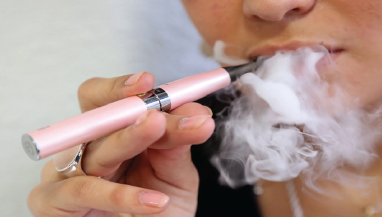After taking the first drag from the mysterious electronic device and realizing no smoke emerges, one may think that smoking an electronic cigarette is a revolutionary idea that will cause no harm. These devices are often deceiving, for the companies frequently portray them as nicotine-free and non-detrimental to health. On the contrary, e-cigarettes do contain nicotine as well as other harmful substances and chemicals such as formaldehyde. Advertisement campaigns and celebrities display them as glamorous, targeting young adults with different smoke flavors and cartoon campaigns. The Food and Drug Administration has not approved e-cigarettes and companies often advertise them as a safe tool to help people quit smoking.
According to CNN.com, the amount of high school students who use e-cigarettes has doubled between 2011 and 2012, with one in ten high school students having tried this controversial device, and 1.78 million grade school students in the U.S. using e-cigarettes daily. Although many believe that they do not contain nicotine, the harmful substance is present in these devices. Due to the release of an unknown vapor instead of smoke, many think that the results are not harmful. However, formaldehyde, benzene and the tobacco-specific nitrosamine, a carcinogen, are found in the vapor of e-cigarettes. Medical News Today reported that e-cigarettes cause harm to lungs as well as increasing airway resistance for the smoker. In addition, e-cigarettes are also considered a gateway to using traditional cigarettes in the future.
“Electronic Cigarettes are becoming more popular at parties,” said junior Brooke Levine. “Most people think that e-cigarettes don’t contain nicotine, so they try it believing that they are safe.”
Tobacco companies are scrambling for new customers and are trying every method to gain more. There are even a variety of fruity flavors of e-cigarettes as well as cartoon advertisements that target young adults and children. “Joe the Camel” was a marketing mascot for Camel cigarettes from 1987 to 1997 and now e-cigarette companies are following suit by using cartoons similar to the controversial camel. The e-cigarette company Blu uses a cartoon couple in their advertising, capturing the attention of children. The FDA previously banned flavored traditional cigarettes, yet there has not been a ban on e-cigarettes as well. Celebrities who smoke e-cigarettes, such as Leonardo DiCaprio, are also setting an example that smoking these harmful devices is acceptable for young adults who look up to them.
Since the FDA has not approved the e-cigarette, the device is not confirmed as a safe alternative for smoking. Therefore, tobacco companies are falsely advertising e-cigarettes as safe. The FDA stated that the risks of smoking e-cigarettes are still unknown and use of the device is not recommended. According to the Huffington Post, smoking e-cigarettes causes breathing difficulties as well as lung cancer, myriad cancers and circulatory disease. Due to the widely unknown side effects of these devices, there may be more harmful health concerns as scientists learn more about this product.
“E-cigarettes have not been fully studied, so consumers currently don’t know how much nicotine or other potentially harmful chemicals are being inhaled during use,” said the FDA in a statement on its website.
New York City has already banned the use of e-cigarettes indoors and many other cities are working to do the same. As of Oct. 1, 2013, a proposal to increase e-cigarette regulation is under review at the White House Office of Management and Budget. E-cigarettes are harmful not only to the smoker but also to others in the form of second hand vapor. Although this device has been romanticized and widely used, e-cigarettes must be regulated before more people face the repercussions.








